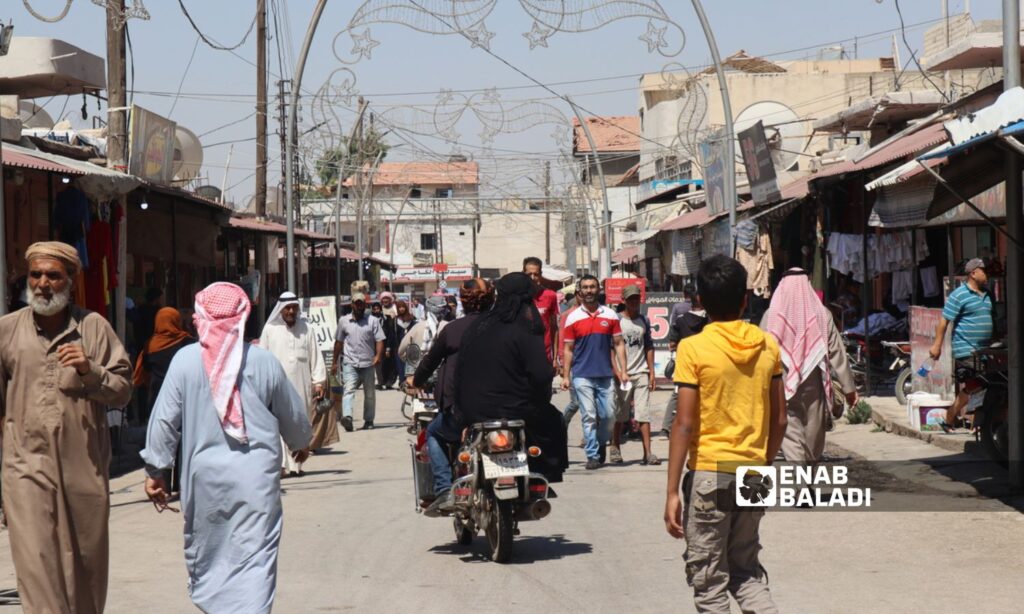Ras al-Ain – Hussein Shaabo
The presence of three currencies in circulation in the border city of Ras al-Ain, northwest of al-Hasakah, places a heavy burden on residents and merchants and complicates their commercial transactions.
The currency in circulation is the Syrian pound, but its turbulent reality and its decline to unprecedented levels have exhausted the people. The second currency is the Turkish lira (not widely circulated) because the city is adjacent to the Turkish border, and the third is the US dollar.
The trading situation is not new, but the deterioration of the Syrian pound since the beginning of this year against foreign currencies and the decline in the value of the Turkish lira have left a negative impact on the lives of the city’s population of about 115,000 people.
The trading rate of the Syrian pound against $1 reached 14,000 this week, and against the Turkish lira reached 27, according to the S-P Today currency website.
It does not satisfy the customer or the merchant
Haiba Adwan, a housewife in Ras al-Ain, said that her family can no longer keep up with the rising prices and the falling value of the pound, and purchasing basic goods such as bread, sugar, and oil has become a burden on her.
Adwan told Enab Baladi that prices rose by about 75%, pointing out that merchants calculate food items in dollars, and the currency in circulation and workers’ wages are all paid in Syrian pounds.
For his part, Abdul-Aziz Kanao, a resident of Ras al-Ain, said that he used to buy a kilo of sugar a few weeks ago for 13,000 pounds, and now he buys it for 21,000 pounds because merchants calculate the price in dollars and people pay in pounds.
Mustafa Ezz al-Din, owner of a vegetable store in the city, told Enab Baladi that he incurred losses amounting to 70% of his capital due to the decline in the value of the Syrian pound. He buys vegetables with the Turkish pound and sells them with the Syrian pound, and the merchant is forced to exchange the two currencies on a daily basis.
For his part, Haitham Shalash, the owner of a food store, considered that the trading situation became unacceptable, as the value of currencies changes every hour, and it is difficult to determine the price of products, and the merchant remains all day counting his losses and the amount of goods he can buy the next day.
Shalash called on the concerned authorities to determine a trading mechanism that is satisfactory for everyone because the fluctuation of the exchange rate of the currencies in circulation threatens the continuation of small and medium businesses at the present time.
Mohammed al-Salim, the owner of a clothing store, is suffering from a decline in demand for purchases due to the collapse of the Syrian pound and the rise in the value of clothes by about 100%, and it has become difficult for customers to keep up with the market price, pointing out that this situation does not satisfy either the merchant or the customer.
Al-Salim explained that the decline in sales threatens the continuity of his business and other merchants, appealing to the concerned authorities to take measures to address what he described as the “economic crisis.”
Replacing Syrian pound with Turkish lira
Habu al-Hadar, director of the Chamber of Commerce and Industry in the Ras al-Ain region, told Enab Baladi that the continued circulation of the Syrian pound constitutes an economic burden on the people and leads to an increase in poverty rates.
He stated that these transactions lead to the disruption of commercial activity, which requires finding an effective solution, pointing out that the Chamber of Commerce is demanding that the Syrian pound be replaced with the Turkish lira, similar to what was done in northern Syria.
Al-Hadar believed that this measure would strengthen the region’s economy and make it more stable, which would benefit residents and merchants alike.
The spokesman for the local council in Ras al-Ain, Ziad Malki, told Enab Baladi that the council is committed to continuous communication with merchants and citizens alike and is aware of the challenges that merchants face as a result of the deterioration of the Syrian pound.
He stated that the council is cooperating with the Turkish side to enhance the circulation of the Turkish currency and prevent dealing in the Syrian pound in the region, but the matter requires time and effort, adding that the Turkish lira will be widely available in the near future, without specifying a date for that.
Ras al-Ain and Tal Abyad are located adjacent to the Turkish border and are controlled by the Turkish-backed Syrian National Army (SNA) and its political umbrella, the Syrian Interim Government (SIG). The border towns are surrounded by fighting fronts with the US-backed Syrian Democratic Forces (SDF), and the Turkish border is considered its only outlet to the outside.
The Interim Government did not adopt the Turkish lira as a currency for circulation in Ras al-Ain and Tal Abyad, despite its adoption in the northern and eastern countryside of Aleppo.
The Salvation and Interim governments, operating in northern Syria, adopted the Turkish lira as a currency for circulation in June 2020, as it is more stable than the Syrian pound, in addition to the circulation of the US dollar in foreign commercial transactions.
The replacement of the Syrian pound with the Turkish lira in the north came after the exchange rate reached 3,500 Syrian pounds per dollar in June 2020, amid demands from Syrians that the replacement be a temporary solution until a political solution is reached.
Despite the adoption of the Turkish lira, the decline in its value against foreign currencies leads to a partial stagnation in the markets and a rise in food prices in general, given that the import movement is from outside Syria via Turkey, and any change in the price of the Turkish lira against the dollar quickly affects the local market.











